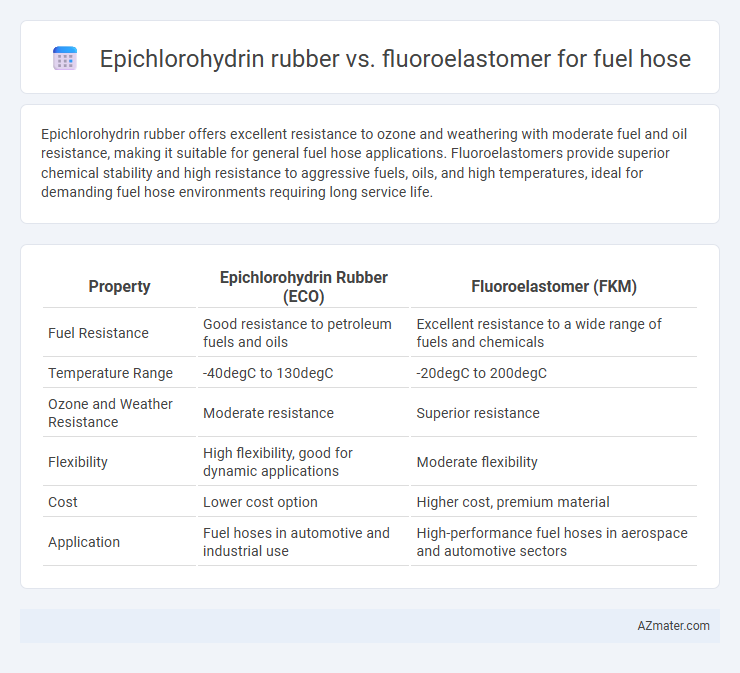Epichlorohydrin rubber offers excellent resistance to ozone and weathering with moderate fuel and oil resistance, making it suitable for general fuel hose applications. Fluoroelastomers provide superior chemical stability and high resistance to aggressive fuels, oils, and high temperatures, ideal for demanding fuel hose environments requiring long service life.
Table of Comparison
| Property | Epichlorohydrin Rubber (ECO) | Fluoroelastomer (FKM) |
|---|---|---|
| Fuel Resistance | Good resistance to petroleum fuels and oils | Excellent resistance to a wide range of fuels and chemicals |
| Temperature Range | -40degC to 130degC | -20degC to 200degC |
| Ozone and Weather Resistance | Moderate resistance | Superior resistance |
| Flexibility | High flexibility, good for dynamic applications | Moderate flexibility |
| Cost | Lower cost option | Higher cost, premium material |
| Application | Fuel hoses in automotive and industrial use | High-performance fuel hoses in aerospace and automotive sectors |
Introduction to Epichlorohydrin Rubber and Fluoroelastomer
Epichlorohydrin rubber (ECO) is a synthetic elastomer known for its excellent resistance to heat, oil, and weathering, making it suitable for fuel hose applications requiring durability and flexibility. Fluoroelastomers, such as Viton, offer superior chemical resistance, particularly against aggressive fuels and high temperatures, which enhances safety and longevity in demanding automotive and aerospace fuel systems. Both materials provide essential performance characteristics, with epichlorohydrin prioritizing low permeability and fluoroelastomers excelling in chemical stability for fuel hose manufacturing.
Chemical Structure and Composition Comparison
Epichlorohydrin rubber (ECO) is a copolymer primarily made of epichlorohydrin and ethylene oxide, featuring a saturated backbone with chlorine atoms providing chemical resistance and flexibility. Fluoroelastomers (FKM) consist of vinylidene fluoride, hexafluoropropylene, and perfluoromethylvinyl ether monomers, characterized by a highly fluorinated carbon chain that delivers superior resistance to fuels, oils, and high temperatures. The chemical composition difference impacts fuel hose performance, with ECO offering good ozone and fuel resistance while fluorinated elastomers provide enhanced chemical stability and durability in aggressive fuel environments.
Fuel Resistance Performance
Epichlorohydrin rubber offers excellent resistance to ethanol, methanol, and moderate hydrocarbon fuels, making it suitable for conventional gasoline and diesel applications. Fluoroelastomers exhibit superior fuel resistance, with outstanding performance against aromatic hydrocarbons, synthetic fuels, and aggressive chemical environments, ensuring durability in modern high-performance fuels. For fuel hose applications requiring extended life in harsh fuel blends, fluoroelastomer materials provide enhanced chemical stability and lower permeability, outperforming epichlorohydrin rubber in long-term fuel resistance.
Temperature Stability and Range
Epichlorohydrin rubber offers temperature stability typically between -40degC to 120degC, making it suitable for moderate temperature fuel hose applications with good resistance to ozone and weathering. Fluoroelastomer, with a wider operating temperature range of -40degC to 200degC, excels in high-temperature fuel systems due to exceptional thermal stability and chemical resistance against fuels and oils. For fuel hoses exposed to extreme heat or aggressive chemical environments, fluoroelastomer provides superior performance and durability compared to epichlorohydrin rubber.
Mechanical Properties and Durability
Epichlorohydrin rubber offers excellent resistance to ozone, weathering, and abrasion, making it suitable for moderate temperature fuel hose applications with good mechanical strength and flexibility. Fluoroelastomers exhibit superior chemical resistance, particularly against hydrocarbons and fuels, and maintain exceptional mechanical properties and dimensional stability under high temperatures, enhancing durability in harsh fuel environments. The choice hinges on operating temperature and chemical exposure, with fluoroelastomers preferred for high-temperature, aggressive fuel systems, while epichlorohydrin is effective for less demanding conditions.
Compatibility with Fuel Types
Epichlorohydrin rubber exhibits excellent compatibility with alcohol-blended fuels and hydrocarbon fuels, making it suitable for use in ethanol gasoline and diesel applications. Fluoroelastomer, renowned for its superior chemical resistance, offers exceptional compatibility with a broad range of aggressive fuels, including aromatic hydrocarbons, biofuels, and aviation fuels. Fluoroelastomer's enhanced resistance to swelling and degradation ensures extended durability in high-performance fuel hose applications exposed to diverse fuel types.
Environmental and Aging Resistance
Epichlorohydrin rubber exhibits excellent resistance to ozone, weathering, and moderate chemical exposure, making it suitable for fuel hoses in environments with moderate aging conditions. Fluoroelastomers provide superior environmental resistance, with outstanding performance against heat, fuels, oils, and aggressive chemicals, ensuring longer service life under harsh aging and high-temperature conditions. Fluoroelastomers also maintain mechanical properties and dimensional stability much better than Epichlorohydrin rubber in fuel hose applications exposed to varying environmental stressors.
Cost Efficiency and Economic Considerations
Epichlorohydrin rubber offers a cost-effective alternative to fluoroelastomers for fuel hoses, with lower raw material and processing expenses contributing to reduced overall manufacturing costs. Fluoroelastomers, despite higher initial costs, provide superior chemical resistance and durability that may reduce long-term maintenance and replacement expenses in demanding fuel system environments. Economic considerations favor epichlorohydrin rubber for applications with moderate exposure, while fluoroelastomers are justified in high-performance fuel hoses due to their extended service life and lower risk of fuel permeability issues.
Applications in Fuel Hose Manufacturing
Epichlorohydrin rubber offers excellent resistance to ozone, weathering, and moderate fuel types, making it suitable for fuel hoses in automotive and industrial applications where flexibility and oil resistance are critical. Fluoroelastomers provide superior chemical resistance, especially against harsh fuels, synthetic oils, and high temperatures, ideal for high-performance fuel hose manufacturing in aerospace and racing industries. The choice between Epichlorohydrin rubber and Fluoroelastomer depends on specific fuel compatibility, temperature range, and durability requirements in fuel hose applications.
Summary and Material Selection Recommendations
Epichlorohydrin rubber offers excellent resistance to fuels, oils, and ozone, making it a cost-effective choice for fuel hose applications requiring flexibility and moderate chemical exposure. Fluoroelastomers provide superior chemical resistance, high temperature tolerance up to 200degC, and exceptional durability against aggressive fuels and solvents, ideal for high-performance fuel systems in automotive and aerospace industries. Material selection should prioritize fluoroelastomers for demanding environments with extreme temperatures and aggressive chemicals, while epichlorohydrin rubber suits applications with moderate temperature ranges and less aggressive fuel exposure for cost efficiency.

Infographic: Epichlorohydrin rubber vs Fluoroelastomer for Fuel hose
 azmater.com
azmater.com